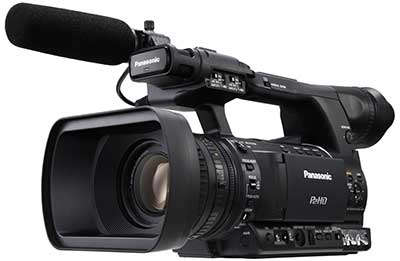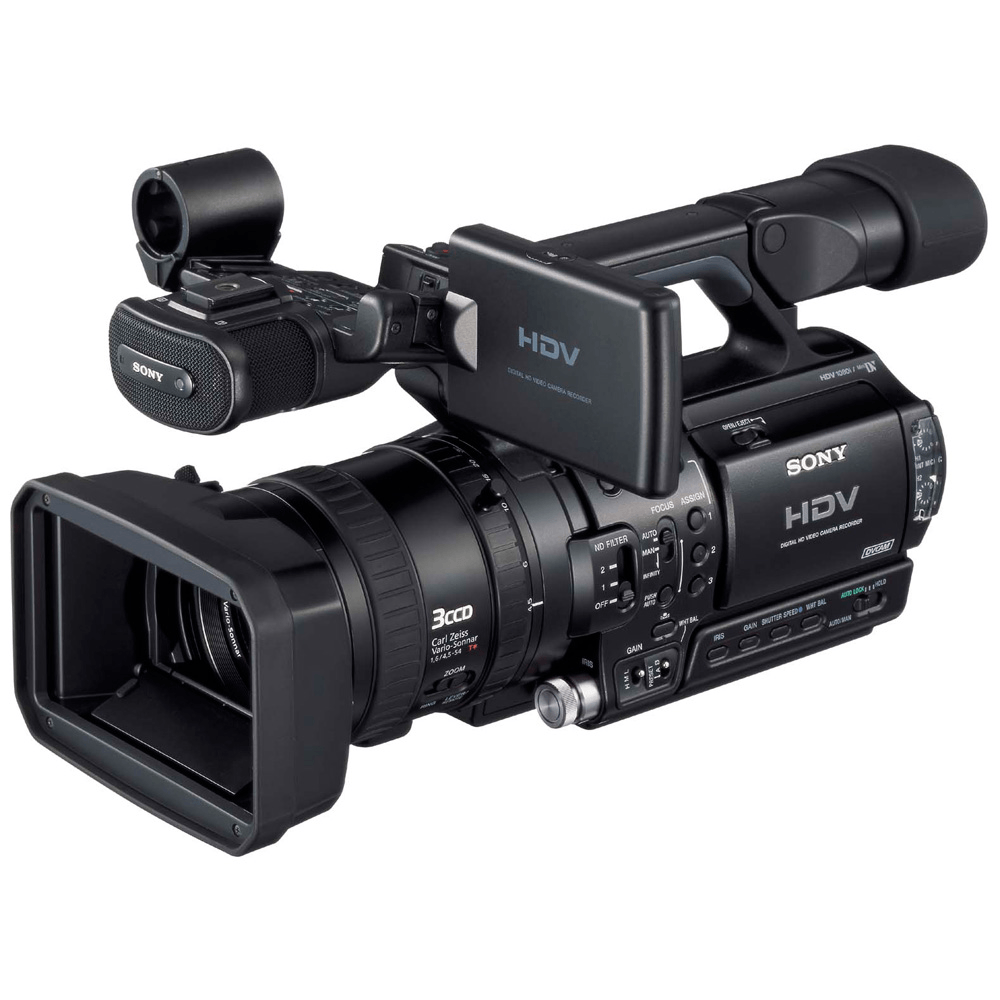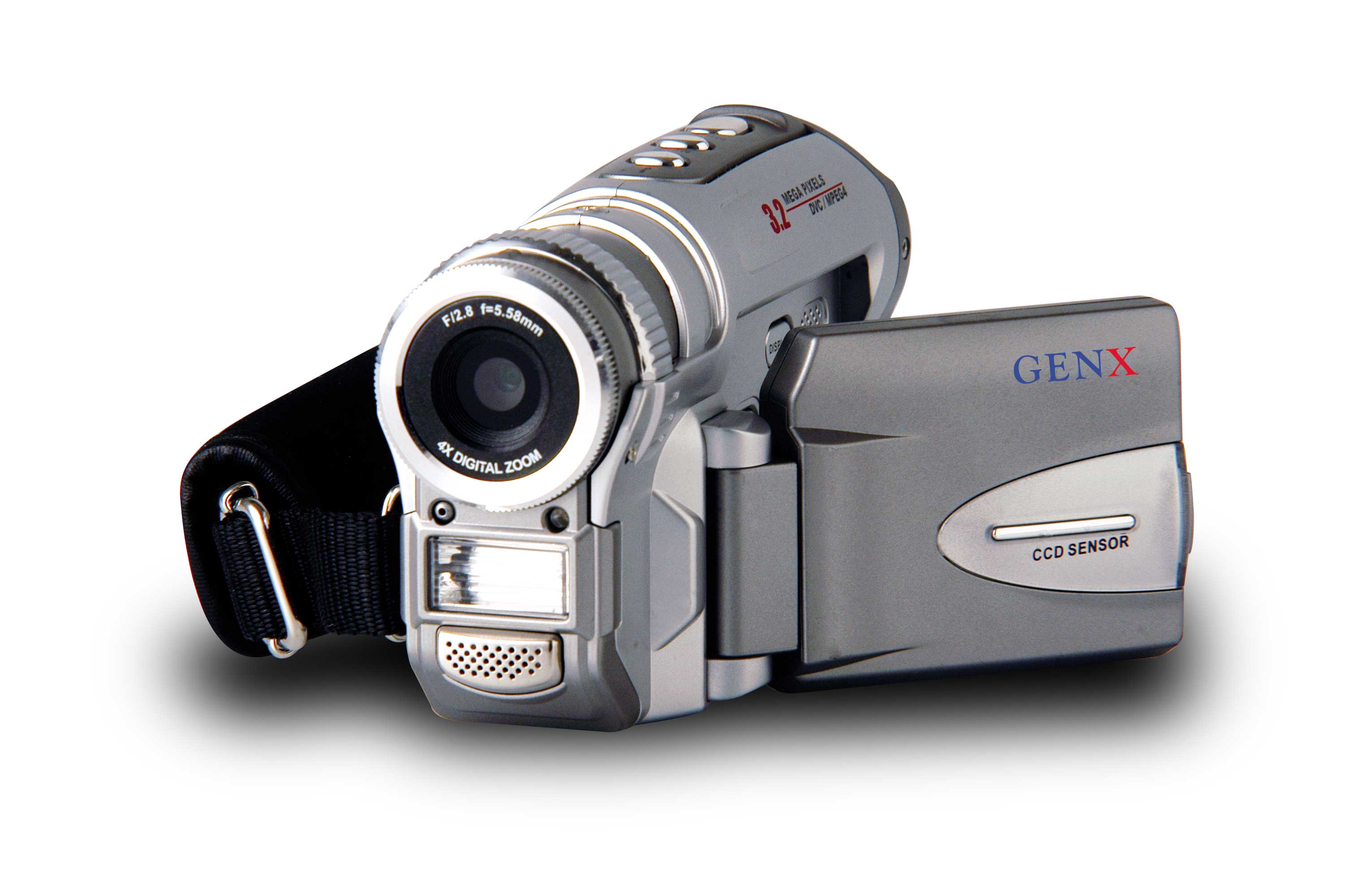Video camera
A video camera is a device for recording images in the form of electrical signals. In contrast to the movie camera, based on photographic technique, the electrically stored image signals can be made immediately visible as images.
To record the sound, a microphone is built on consumer and prosumer models; professional cameras (eg for Broadcasting) instead have connections. It differently specialized microphones are connected according to the situation. In a broader sense, digital cameras are referred to as video cameras. Many smartphones can record videos. A video camera with integrated video recorder called camcorder.
- 3.1 Separation into three monochromatic images
- 3.2 color separation at the pixel level
- 3.3 Sequential color separation
- 3.4 Comparison 1 -chip and three -chip CCD - method
- 7.1 Analog Output
- 7.2 Digital Output
Imager
CCD
CCDs were an important step towards the miniaturization of video cameras dar. Meanwhile, they exceed the quality of Ikonoskopen significantly. For especially high quality cameras, the image sensors are cooled. This allows much less noisy images. The noise is 16 dB be barely noticeable even after amplification (gain). Cheap cameras do not have a diaphragm, but to regulate the exposure of the charge time.
The larger the area of the image sensor used, the more light can be "captured". This increases the sensitivity of the chips used, which occurs particularly in low light noise is reduced. Common sizes are 1/6 ", 1/ 4", 1 /3, 4 ", 1 /3" or 1/2 " (1" = 2,54 cm). The resolution of the imager does not necessarily confirm anything about the actually offered resolution. The pixel indication on the case usually refers to the pure photo function. What number is used for video recordings, is usually not highlighted so clearly. Part of the specified pixel is often used for the digital image stabilizer. It is interesting only the net amount of pixels, which is actually used for films. Usually, these values are in the megapixel range or just below ( 800,000 pixel is a quite typical value for PAL cameras ). Can be stored anyway no more than is required, for example, the European standard (PAL format): These are 720 × 576 pixels. In high-quality cameras and professional equipment to film production, such as HDCAM, three 2/3 " sensors with respective resolutions of well over 2 million pixels are used.
CMOS sensors
This kind of image sensor, also known as active pixel sensor that uses CMOS technology. These sensors were initially found mainly in very cheap cameras. After the meantime taken place further they are also used for demanding monitoring tasks and for image processing. The CMOS chip captures the image continuously, so it can be read at any time. The number of frames per second depends on how high the pixel frequency and the number of pixels of the read-out image detail, but is higher than that of the CCD chip. Individual pixels can be programmed in their functionality and read out individually or in groups. The dynamics ( the range between the weakest and the strongest yet properly recorded signal) of the CMOS chip is significantly higher than in the CCD chip, extreme lighting situations (eg -beam headlights at night in an unlit tunnel ) can with unprecedented precision are shown. The so-called smear little or does not occur with CMOS sensors. In addition, the CMOS technology is characterized by low power consumption and high frame rates (up to 300 kb / s versus 100 kb / s with the CCD technology). Despite these considerable advantages of CMOS technology, the CCD technology is not superior in every respect.
Iconoscope
The Iconoscope ( Greek) is a television camera tube, which was invented by Vladimir Zworykin K. 1923 and containing a layer of microscopic photocells, which are scanned by an electron beam. The Ikonoskop took over from mechanical scanning. Later, the Ikonoskoptechnik has been further improved and not until the 1990s used.
Nipkow disk
The first video cameras were based on the so-called Nipkow disk. This is a round disc 30 with holes which are arranged in the form of a spiral. The image is projected on a rectangular area of the disc. The path of the holes in this area causes a line scanning of the image: a hole always moves in a direction to vanish at the boundary. Then the next hole emerges slightly further down on and scans the next line. The whole light passing through thus provides the video signal and is received by a fast photodetector (photo cell).
More information on this topic can be found under mechanical television.
Vidicon
The vidicon system also uses a cathode ray tube and is still in special applications (medicine, Radiation exposed places ) are used.
More information about image scanning electron tubes can be found in Article image pickup tube.
Entry into the film business
From 2000 camcorder began to be available, which were focused on film production, as the most important group the devices by the HDCAM standard. These camcorders cost as a system of five -to six- figure sums and were used from their availability by some directors, producers and camera men for the productions. These digital cinema cameras vary enormously from their conspecifics for TV production and home users.
Now CMOS sensors are used with more than twelve megapixel digital cinema cameras and sensors have S- 35mm film image size. Examples include ARRI D -20, Dalsa or RED.
Color separation
To generate a color video signal, one needs three color components (red, green, blue)., Additive color mixing and light colors from the color theory known as RGB.
Separation into three monochromatic images
The most obvious way to achieve the Farbbtrennung it, and couple three image sensor for each color to be used ( "Three -Chipper " ) through an optical system, which also takes on the color separation filters is. In the age of the vidicon, the process was in use. Today's 3- chip cameras distribute the falling through the lens through prisms and beam splitters to three monochrome CCD chips. Through color filter is reached, that a chip receives the green components, the other two each red and blue, respectively. This process leads to very high-quality images and is therefore used in the professional field.
Color separation at the pixel level
Particularly in inexpensive cameras ( " A -Chipper " ) a different procedure is used. The CCD chip submits each pixel alternating color filters of each color, so that different adjacent image points record different color components. An electronics generate therefrom a color video signal. The required higher pixel count ( per pixel 2 x green, 1 x red, 1 x blue) usually leads to a poorer resolution; but in any case, the color is not as accurate as in 3-chip camera. An image recorder which uses this method, the Bayer sensor.
Sequential color separation
Before you experimented with sequential color separation. A rotating color filter filtered out alternately the three color components. A same filter rotates synchronously with the receiver in front of a white glowing display tube, the result is there for the eye, a color image. These experiments were set but soon. In space using such color filters yet, since very many frequency ranges are required.
Comparison 1 chip, and 3- chip CCD method
After the PAL format ( American NTSC format) 576 pixels are displayed on the television screen 720 ×. To save the complete information in the camcorder, the chip would have to have at least 414,720 × 3 pixels. Since the image points are oblong in PAL, but are actually 768 x 576 square always the CCD / CMOS pixel, for a total 442.368x3 needed, which are then converted to 720x576. In 16:9 recording 1024 x 576 = 589 824 x 3 are necessary pixels, which is also in 720 x 576 pixels, but squashed anamorphic, be converted. (Note: Since image sensors usually have an aspect ratio of 4:3, actually have image sensors are installed in 16:9 - capable cameras, the 1024 (horizontal resolution of 16:9 PAL) × 768 (3/ 4 of 1024) = 786,432 have pixels. has the sensor less pixels, it can be assumed that no true 16:9 image is generated, but a cut is scaled from the 4:3 image (blow up). ) The number must be multiplied by three, as a pixel can not perceive the entire color information, but only differences in brightness. On a 3- chip model colors are separated by a prism into the components red, green and blue (RGB) and distributed to the three chips. Excluding a digital image stabilizer, these pixel numbers would be sufficient to reproduce all the required image information at a TV screen.
For a 1 - chip model image storage is done in other ways. Since each CCD pixel only perceive differences in brightness, a color filter ( Bayer filter ) with either green, red or blue is placed in front of each pixel. The DV signal is recorded in a ratio of 4:2:0 ( YCbCr color model). With Y is the luma component is referred to, which stores only the luminance differences, and U and V represent the color difference component (chroma). This means that for each pixel the brightness of four pixels and only one color value are stored. Because the human eye to differences in brightness much more sensitive than color differences, this reduction can be made without great losses.
When calculated for a representation of a set of pixels of 720 × 576 × 3/2 = 622.080. It needs to be multiplied by three because three pixels are required for each color. By the reduction of ( 4:2:0 ) to YCbCr color model, the half ( divide by 2) is saved again.
If a digital image stabilizer is used, the required amount of pixels can again increase by 60 % or more.
The comparison shows that a one - chip model now may well produce identical qualities such as a 3-chip model. With the 1 - chip model (1 -Chipper ) the quite complex optical image segmentation is saved. With ever higher resolution sensors - today (2004) chips with more than 8 million pixels in digital photography are not uncommon - can 1 -Chipper competitive with 3-chip assemblies.
It's always a higher resolution for the same chip size is always accompanied with increased image noise. In low light situations, the situation can then be shown that the low -resolution camera with a larger chip a much better picture returns as the newest, ultra high resolution camera with a 1/6 " chip A rule of thumb for buying not say nothing. " The take the largest image converter, which you can get. " This means the current state (2005) in the consumer - to Prosumerbereich 1/3 " to 2 /3 ".
Image Stabilizer
Lens
The lens used is the most important component for achieving good results. Even the best electronics can not compensate for what " spoiled " already in the lens (eg, blurring, vignetting, distortion, chromatic aberrations). The lens must not only the required resolution and sharpness of projected on the imager, but at the same time may also produce very little or no stray light. This is achieved by coating the lenses, indicated by a bluish or - more rarely - brownish glow of the front lens. For the optical zoom zoom lenses are used; there are virtually no more video cameras without optical zoom. The digital zoom is nothing more than an enlargement of the electronic lens supplied by the image converter image. In this case, however, the pixel structures are equally magnified as the actual motive. The resolution is reduced depending on the magnification scale to the impracticality of a digitally zoomed image. In contrast, the optical zoom will deliver the same resolution at different zoom factors. Since wide-angle lenses are more expensive to produce than other lenses, is usually very small video cameras of wide-angle and macro range. While it can be created through the use of corrective lenses intent, the overall image quality is however basically worse. Useful Wide resolutions are very expensive. The - as yet - automatic focus control can be affected by resolutions of the lens.
Designs
Camcorders have numerous possible differences in their specific configurations, which are determined by their intended use and price. The following is an attempt to represent the various distinguishing features of the known designs is made.
- Carrying and attitude design: Here is between shoulder cameras that are out on the shoulder, and hand-held cameras, which are held in front of the body, distinguished. Shoulder cameras have, at the bottom of a molding to rest on the shoulder and a corresponding shoulder located in the center of gravity. The trigger is usually located in a growing front right, with which the camera is also stabilized with the right hand. The viewfinder is mounted sideways. Hand-held cameras are usually lighter and more compact, the viewfinder is usually at the rear of the camera, the shutter at various points, according to the manufacturer's assumptions about how the camera is held.
- Recorder Cultivation: In the vast number of camcorders provide camera head ( with consumption of electronics and control panel) and the recorder part of an integral unit. For more sophisticated cameras there are, however, models in which the recorder is plugged into the head, and which therefore can be recorded by the recorder exchange on various media.
- Change in the hand-held cameras: The recent development (as of 06/ 2012) has led to self- System digital cameras, bridge cameras and even " pocket " or "Traveller " cameras (often with " super-zoom capabilities " ) to the "Video camera " can be counted. AVCHD lite dominate even relatively cheap cameras, whereas the higher quality models with full HD up to 1920 × 1080 pixels can come up with 50p.
Electrical and software interfaces
There are different levels of preprocessing of the image signal of a video camera. The analog and digital data formats is the serial output together.
Analog Output
Line by line scan and output the brightness information of all (black / white) or the three individual colors.
- Output of the color information and brightness as well as the synchronous signals
- Output of all information on a line (mixed signal or composite video, PAL -coded)
- Separate output of the three color intensities and the synchronizing signals ( line and frame sync)
Digital Output
Serial digital data interfaces for video cameras are eg FireWire (IEEE1394, Sony: iLink ) or USB 2.0, and for transmitting uncompressed data on SDI and HD -SDI or SDTI of compressed data.
During the transmission of video data to a PC connect via IEEE1394 is always preferable to the USB connection.
To convert analog video signals into digital data formats, there are adapter modules.
Software interface for a video signal on a computer are used to display, processing or storage of image sequences ( videos), examples: SANE TWAIN.










